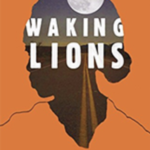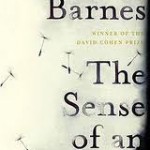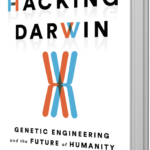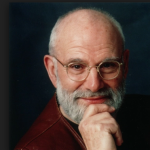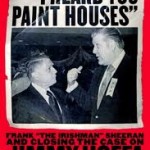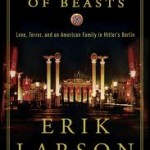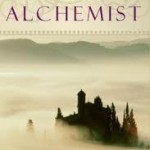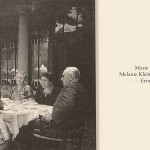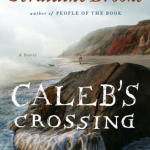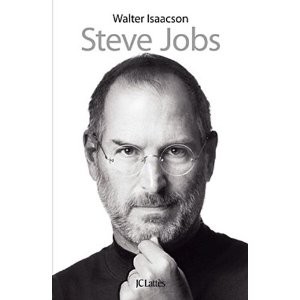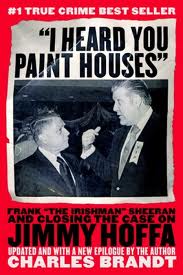Search results for ‘Jobs’
Steve Jobs by Walter Issacson
January 12th, 2012 — 12:16 amI have become an Apple person. The more I use their products the more I like them. I have known for awhile that Steve Jobs and Steve Wozniak, working in a garage conceived the idea for a personal computer and built the prototype of the first Apple computer. However, I knew very little more about them and how they made Apple what it is today. When Steve Jobs recently died in his fifties, I felt a personal sadness. They guy who was responsible for so much of my everyday efficiency and pleasure in communicating and trying to do creative things had died. So when I learned that that Jobs had asked the well know biographer Walter Issacson to not only write his story but to pull no punches, interview anyone and have final edit on the book, I decided I was going to read it.
The book met my expectations in every way. Not only did it trace the evolution of Apple, it’s products and it’s philosophy but it traced the evolution of Steve Jobs. In the end I would agree with the author that Jobs has to be rated as some kind of a genius along with Thomas Edison and Henry Ford because it was his single-mindedness that brought about so many drastic changes in so many people’s lives. But his personality was something else. The same qualities that led him to persist until he received the results that he wanted let him to treat so many important people in his life with insensitivity and at times downright meanness. As a psychiatrist I avoid trying to make a psychiatric diagnosis of someone I haven’t seen personally in some depth. Despite the report in this book of many personal conversations with him and interviews with many people who knew quite well, I don’t think I could make a diagnosis even if I were inclined to do so. Somewhere in the book someone speculated that he was on the autism spectrum and an old girl friend who was involved with the mental health profession was sure that he fit the criteria for narcissistic personality. There is no doubt that he was a unique person who interacted and befriended many people. He established what seemed to be a good marriage and loving children and even kept in contact with a child born out of wedlock and a sister, with whom he wasn’t brought up with, once they found each other. He clearly identified with the father who raised him up and interestingly enough by coincidence he met his biological father who ran a restaurant that he would frequent but never realized he was that person when he interacted with him.
Just as much as Steve Jobs revolutionized our way of life in regard to how we communicate and handle information and pictures through his development of the Apple computer, he did just as much to the way we listen to music. The music industry was becoming disorganized and quite problematic as people began to move from buying CDs to downloading music on line. Initially it was through Napster and music sharing which was unreliable and essentially illegal pirating of the music since the artists and the recording companies did not receive any proceeds for their products. In several strokes of his genius Jobe led the development of the ipod which allowed you to listen to your music on the run ( of course the SONY Walkman had started that ), shuffle the music and most important download just about any song by just about any artist for usually .99 cents. In order to bring this about Jobs had to convince the major recording companies and their contracted artists to agree to sell their music through the istore and allow Apple to have part of the proceeds. Since the organization of the ipod was done on the Apple computer, this sold more Apple computers. Even when Apple licensed some of their software to the PC people so they could buy through the itunes, the istore Apple reaped in more profits. Then there was the story how Jobs changed animation movies through his establishment of Pixar and all his interactions with the Disney people.
Issacson, in discussing the music revolution led by Apple and Jobs, chose to gain and share a good insight into his subject as he asked him an iconic question, “What is on your ipod?” Jobs’ discussion of the music that he loved in the 70s (some of which originated in the 60s) as well as tracing his attraction and attachment to more modern popular music is revealing of the man and his passions. I found particularly interesting was his analysis of two recordings of the same song by a few artists done at the beginning and at the end of their careers. The evolution of his taste and attraction to two different interpretations by the same artists reflected his own growth, maturity and outlook on life. I also loved the question put to Jobs as to if he could only preserve the original master recordings from his vault of only one artist or group who would it be? It came down to the Rolling Stones, the Beatles or Bob Dylan. You will have to read the book to find out who and why?
In preparing an advertising campaign for Apple products , Jobs worked very closely with his media people to establish and create a specific tone. The following is one example which I thought might very well be Jobs defining himself and can also be a tribute to him :
Here’s to the crazy ones. The misfits , the rebels, the troublemaker, the round pegs in the square holes, the ones who see things differently. They’re not fond of rules, And they have no respect for the status quo. You can quote them, disagree with them, glorify or vilify them. About the only thing you can’t do is ignore them. Because they change things. They push the human race forward. And while some may see them as crazy ones, we see genius. Because the people who are crazy enough to think that they can change the world are the ones who do.
I found reading the book made me appreciate my everyday Apple experience whether it is appreciating the architecture of my local Apple store or my everyday interaction with my MAC, iphone or anticipating the new products down the line. They all started with one guy and some buddies in a garage. How about that?
Last Days of NIght by Graham Moore
November 18th, 2020 — 11:20 pmLast Days of Night by Graham Moore
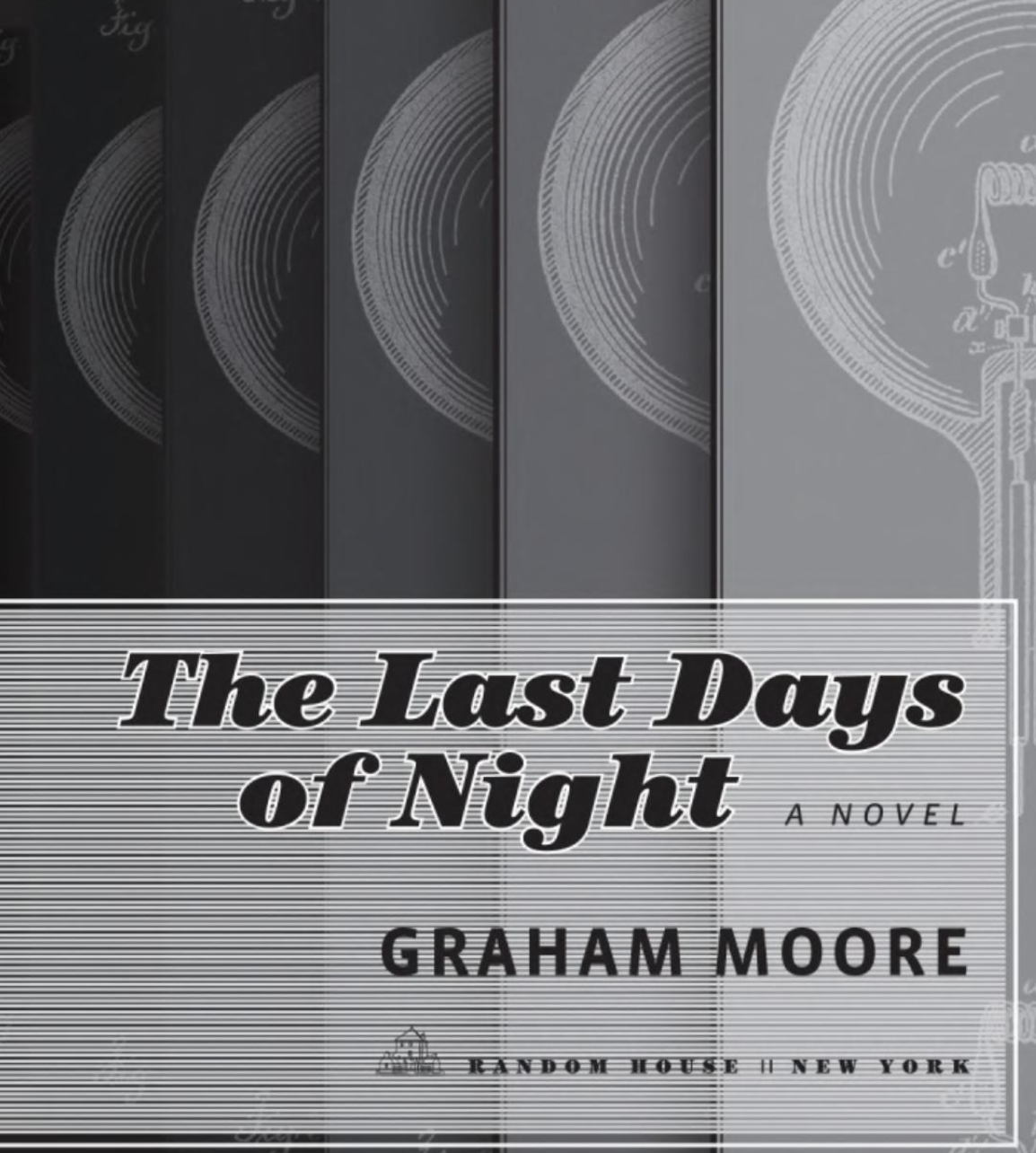 To New Yorkers Cravath may bring up the name of a very well healed prestigious law firm. Apparently, one of the founders of this law firm when he was just starting out is one of the main characters of this book. Circumstances brought Paul Cravath to represent George Westinghouse, a pioneer inventor who is being sued by another prestigious inventor, Thomas Edison, who had invented direct current electricity and the light bulb and who would eventually be credited with inventing motion pictures and playing a major role in the invention of the telephone. This is a book of historical friction, which examined the fascinating conflicts between these two men along with the role played by another genius inventor, Nikola Tesla.
To New Yorkers Cravath may bring up the name of a very well healed prestigious law firm. Apparently, one of the founders of this law firm when he was just starting out is one of the main characters of this book. Circumstances brought Paul Cravath to represent George Westinghouse, a pioneer inventor who is being sued by another prestigious inventor, Thomas Edison, who had invented direct current electricity and the light bulb and who would eventually be credited with inventing motion pictures and playing a major role in the invention of the telephone. This is a book of historical friction, which examined the fascinating conflicts between these two men along with the role played by another genius inventor, Nikola Tesla.
As we sit comfortably in our well-lit home and read this book, we may not appreciate the differences between direct current and alternating current and the nuances of various electrical bulbs. While much of the dialogues and events in this book are fabricated they are based on true conflicts and events. There is also a fascinating description about the first electrocution by electric chair, which was quite messy and witnessed by the press. The insight into these characters while done with some poetic license is never the less quite fascinating. There was even a cameo by Alexander Graham Bell, another inventor of the telephone.
A couple of years ago, there was a movie based on these electric characters called “The Current War” but this book provides more depth and holding power than the film in our opinion. In other words, it was a page turner. In between the chapters, there were various quotes from famous inventors over the years. While they were interesting on their own, they did not relate to the content of the previous or the next chapter and therefore this writer felt they were an unwelcome diversion.
I do not know if there was a major conflict between Bill Gates and Steve Jobs about the invention and development of the computer, but it would not surprise me if it has not been written already that there will be a fascinating story about that relationship as there was this look at about an electrical story of the past (2020).
Ghettoside: A true story of murder in America by Jill Leovy
October 10th, 2017 — 08:26 pm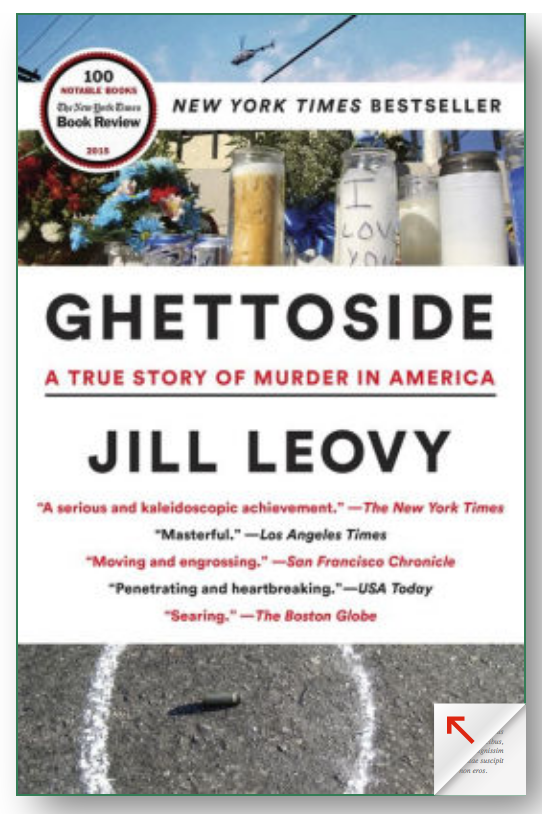 Ghettoside by Jill Leovy
Ghettoside by Jill Leovy
This is a very sad book. It is a story of homicide in the so-called Ghetto area of Los Angeles. Most of the victims and perpetrators are young black men and boys. Not surprisingly, these murders are often gang related, sometimes revenge for previous murder or because somebody is believed to be a “snitch”. Other times the victim was just in the wrong place at the wrong time. Many of these murders don’t even get mentioned in the newspapers or on TV. It’s not unusual for there to be a couple of murders per night in each police district. These crimes may occur in a family where there is a tradition of crime and violence. But on the other hand, sometimes the victim is a high school kid who seemed to be on verge of breaking out of this cycle of crime. Countless families become devastated by this epidemic of murder as the author skillfully and vividly described in so many cases. At times the reader just wants to say, “Enough!” as it it is quite painful to read this book.
The book is also about the Los Angeles homicide detectives and their dedication and professionalism. We see countless examples of how these detectives deal with the horror and indescribable painful situations that they have to view every day. We see their patience and empathy as they speak to family members of murder victims and often making a death notification. This reader was blown away by their ability to do this type of work on a day-to-day basis and treat each murder with care and individuality. We follow some very skillful, dedicated detectives who do their jobs with great respect for the victims and their families.
The juxtaposition of getting insight into the impact of these murders on the families and the professionalism and dedication of the police homicide detectives was quite interesting. However, nothing was more dramatic and eye-opening then when one of the homicide detectives’ sons was murdered and we follow another detective as he applies his intellectual and emotional skills to follow and solve this case through the court room and final verdict. It was clear that this LAPD homicide detective did his best to bring justice to this case in the same manner that he handled all his other cases.
This book really gives a wonderful window and insight to how the police, despite difficult circumstances and at times limited resources, do a job about which they and all of us should be very proud. Reading this book is as engrossing as any TV show about crime and it probably brings the reader closer to the real thing than any movie or novel could do. It is all true and happening every day in Los Angeles and in many other cities throughout the country
To purchase this book from Amazon please click here
Hillbilly Elegy by J.D. Vance
December 16th, 2016 — 01:05 am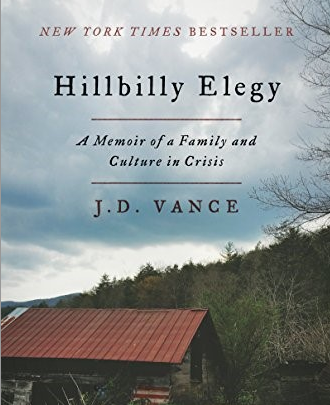 Hillbilly Elegy: A Memoir of a Family and a Culture in Crisis
Hillbilly Elegy: A Memoir of a Family and a Culture in Crisis
by J.D. Vance
This is a compassionate view of the white lower working class in which the author grew up. It provides an insight to the part of rural America which supported the incoming President of the United States, Donald Trump. The author proudly wears the name “hillbilly” and acknowledges that many parts of America look down upon that designation.
J.D. Vance grew up in Middletown, Ohio after his grandparents immigrated from Kentucky where coal mining jobs and other work were drying up and the mills and factories of the Mid-West seemed to offer opportunity for employment and some upward mobility. As we know, more recently there have been rough times for this area which became known as the “rust belt.” If you are not coming from a family of some means that is handed over to you, one must rely on the character traits that you have that will motivate you and allow you to navigate in this world. Family is very crucial here. J.D. Vance certainly did not have a role model from his parents. His mother, who showed flashes of caring for him did not provide emotional or any other type of support. She was a drug addict who ran through about five different husbands.
J.D. Vance’s saviors were his grandparents. His grandfather known as Papaw was probably an alcoholic who at least had a job but didn’t form any strong bond with the author. The most important person to him in his youth was his grandmother known as Mamaw – a very tough woman with whom he periodically lived and who gave him confidence in himself. He was obviously bright but came very close to dropping out of high school. Thanks to Mamaw, an occasional teacher and perhaps one or two other relatives he developed the “right stuff” not only to graduate high school but then had the where with all to join the United States Marine Corps where he served for four years. Having recently seen the movie “Fences” starring Denzel Washington and Viola Davis, we also appreciated another situation where joining the Marine Corps after high school, in this case a young black man was able to receive support and direction that he couldn’t get from his family.
J.D. Vance’s success in going through Ohio State University after the Marine Corps and working at various jobs to provide him money that he needed reflected his determination. He was then surprised at getting accepted at Yale Law School with very good financial support because he was probably the most needy student that was admitted that year. His observations of what it meant to be a student at Yale Law School were notable. He made the point that it was the connections and the networking which made all the difference in the world and opened so many doors for him.
Mr. Vance on one hand makes the point that self-will and determination are the necessary ingredients to succeed in the world but he also says that he wouldn’t have succeeded without the love and confidence in him provided by his grandparents. Without these factors he is sure he would not have made it out of Appalachia. This book informs us about the lives, trials and tribulations of people that many of us might never meet. It provides important insight and raises some very stimulating questions. It is a book well worth reading.
To obtain a copy of this book from Amazon, please click here
Moving On- A Life by Oliver Sacks
December 18th, 2015 — 09:48 pmMoving On – A Life by Oliver Sacks
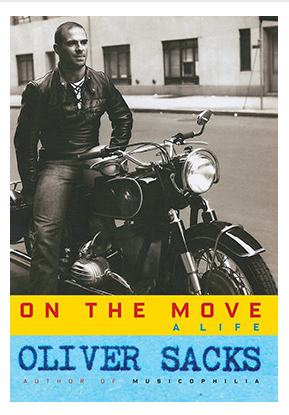 I never read any of his books other than this biography. I read about many of them. I don’t recall hearing him speak in person although I believe I attended one of his lectures at the American Psychiatric Association meeting. I was familiar with many of the places that he spoke about in New York, San Francisco and Los Angeles and I even had some friends and colleagues who knew his analyst, David Shengold. Although I was never anywhere near being in his league as a clinician, writer and brilliant mind, his areas of interest had always fascinated me. So I guess you can say in reading this book, I had a certain amount of kinship and empathy for him although in many ways he was miles apart from my world.
I never read any of his books other than this biography. I read about many of them. I don’t recall hearing him speak in person although I believe I attended one of his lectures at the American Psychiatric Association meeting. I was familiar with many of the places that he spoke about in New York, San Francisco and Los Angeles and I even had some friends and colleagues who knew his analyst, David Shengold. Although I was never anywhere near being in his league as a clinician, writer and brilliant mind, his areas of interest had always fascinated me. So I guess you can say in reading this book, I had a certain amount of kinship and empathy for him although in many ways he was miles apart from my world.
He was born in England to a Jewish family. Two of his cousins were Al Capp, the famous cartoonist and Abba Eden, a famed Israeli Prime Minister. One of his brothers was schizophrenic and we can’t help wondering if his desire to crack the code on the workings of the brain may have had its origin with that experience. Both his parents were physicians and he has early memories of hearing them discuss interesting cases. His father thought it was a shame when a case was written up in the popular press but his mother was a great storyteller. No doubt it was at his parent’s knee that he became fascinated by case histories.
The reader of this book will benefit by his ability to tell good stories. At times he jumps around and he may lose you with the exact time sequence but that will be a small price to pay for an interesting story of a brilliant man who led his life, well lived, his way.
It was his misfortune to be born gay at a time when it was considered to be a choice, rather than an inborn destiny that we know it is today. It is sad to hear that after he had his first sexual experience, he had none for the next 35 years. It was heartwarming to see that he fell in love and was able to live a happy intimate life with a man in the twilight of his life.
In a small way, I could relate to his early fascination with the working of the brain and the scientific advances that were occurring, as he was completing medical school and making the decision to become a neurologist. This was approximately the time that I was in college in the late 1950s. I had participated in a special project where we implanted electrodes into the brain of a cat, in which we could then record after the cat had recovered from surgery and resumed it’s relatively normal life. There were situations where we could tell in advance when the cat was going to make a decision, based on the brain waves before the cat made them. It was very tempting for me because of this experience to want to choose a career in neurology but for me, clinical psychiatry beckoned and that became the direction that I took. We are all fortunate that Dr. Sacks followed his interest in the workings of the brain.
When Dr. Sacks came to the United States, he was in his ‘20s and his first stop was San Francisco where he became an intern at Mount Zion Hospital. Not only was this young doctor quite fearless on his motorcycle but he was also fearless in his self-experimentation with LSD, PCP, later known as Angel Dust and who knows what else. I am sure his experience with mind altering drugs at this time paved the way to his lifelong study of the brain and the workings of the mind.
He dropped a tidbit taking place during this time period about how he got out of the draft. I know firsthand that young doctors were subject to being drafted into the military during both the Korean War and the Vietnam War. It was in 1968 that he said that he persuaded the draft board that he was not suitable material for the draft. I wonder what this was all about.
As someone who has worked in academia, I was particularly interested in what he had to say about one of his first jobs working in a clinical research lab. He reports that on his own, he made observations that he felt merited a write-up for a journal. When he wrote his first paper and it was accepted for publication, his boss was furious and fired him and then according to Dr. Sacks used some of his data which the boss claimed was his own for another publication. I have seen similar situations where there is conflict between the young person and the father figure. I can’t help wondering what would have happened if Sacks had tried to collaborate with his boss. In later years, he described getting along well with his colleagues and sharing data and theories but on the other hand, there seems to be a certain lone wolf quality and approach to his ultimate final products. I really can’t say if he was generous in allowing co-authorships with younger colleagues when he was the famous established author.
His life in Southern California was particularly fun to read about, since he had a house in Topanga Canyon, which is near the area where I now live. He reports zooming around on his motorcycle and it was obviously quite different than it is now, trying to get around on the busy freeway. He reports that he became the doctor of sorts to the Hells Angels, as well as being a Venice Beach bodybuilder.
He really seemed to come into his own once he came to New York. One might have expected him to join the full time faculty at one of the many outstanding medical schools. Instead, he decided to become the peripatetic neurologist by being a consultant to the Beth Abraham Nursing Home , the Little Sisters Nursing Home, both known as “ Manors,” among other places. It was here that he made his groundbreaking observation on post encephalitic patients who received L-DOPA and have their “Awakenings,” often temporary but revealing great insight into the workings of the brain.
His book, by the same name became a New York Times bestseller for 26 weeks and was made into a screenplay by Harold Pinter and into a great movie in which he was played by Robin Williams. This was followed by a number of other world famous books such as The Man Who Mistook His Wife For His Hat, Hallucinations and many others
In his heart and soul, it was clear that he was a storyteller. His understanding of neurology allowed him to listen and observe his patients and make insights that were not only fascinating but were important scientific advances for his time. He was also able to educate the public with his ability to write and make his case histories come alive as real people with unusual problems. He was unbelievably prolific and accumulated thousands of diaries filled with observations of his patients and of the people that he met and interacted with. He became friends and corresponded with some of the great minds of his time, such as Francis Crick (of the DNA guys Watson and Crick) and Stephen Jay Gould as well as Gerry Edelman, author of the groundbreaking book, Neural Darwinism which Sacks explains in great detail in the biography.
Although I don’t think he mentioned it his book, I read elsewhere and that some of the subjects of his writings didn’t like that they were described in a manner in which t they could be recognized. Perhaps he didn’t get what we now call “informed consent.” He obviously wrote because of his love of the subjects he wrote about as well as because of the love that he had for these people whom he got to know.
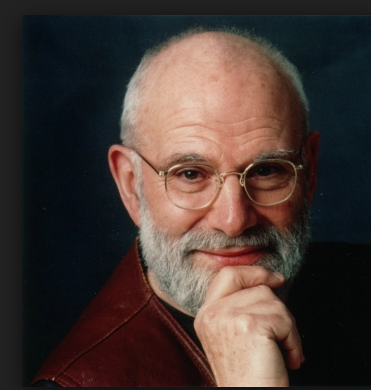 One of the most important subjects of his writings that he definitely had permission to write about was himself. When he severely injured his leg, he was able to write a book titled A Leg to Stand On. In his waning years, he developed a melanoma in his retina. This stimulated him to enlarge upon his earlier observations about vision and consciousness. No doubt , he developed a personal attachment to the people he wrote about but he seemed to be also writing for the personal gratification and acceptance of himself and his works. He related a situation where due to one of his books receiving bad reviews, he went through 3 months of being severely depressed .
One of the most important subjects of his writings that he definitely had permission to write about was himself. When he severely injured his leg, he was able to write a book titled A Leg to Stand On. In his waning years, he developed a melanoma in his retina. This stimulated him to enlarge upon his earlier observations about vision and consciousness. No doubt , he developed a personal attachment to the people he wrote about but he seemed to be also writing for the personal gratification and acceptance of himself and his works. He related a situation where due to one of his books receiving bad reviews, he went through 3 months of being severely depressed .
Oliver Sacks certainly lived his life to the fullest, He received much recognition for his work. He was also recognized by the Queen of England and honored with the designation of Commander. Not only did he receive much satisfaction from his many accomplishments, but he was able to share so much of his thought process and insights with the people who read his papers and books. He passed away a few months ago (August 2015) but I’m sure that his stories and observations will live on for many generations.
Mary Coin by Marisa Silver
October 10th, 2014 — 11:50 am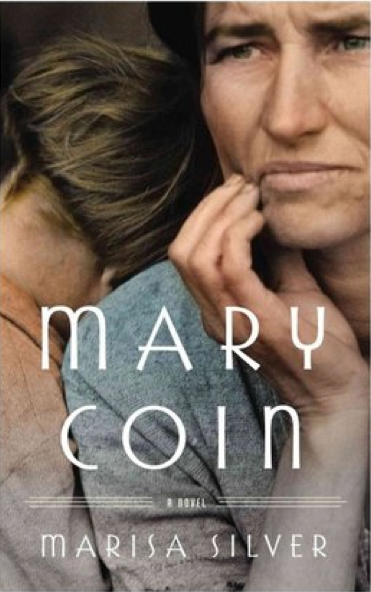 Mary Coin by Marisa Silver– It is a safe assumption, that just about everyone reading this review is familiar with the iconic photograph which is the book cover of the novel being reviewed. You probably know it was taken in California during the Great Depression, It has become known as the “The Migrant Mother.” But who are these people? Where did they come from, what was their life like and what was it like to live in those times? Marisa Silver the author of this novel was not content with just wondering about these things. She wanted to really understand what was going on. She obviously studied the history of this time and place, She created a story that goes beyond the picture but attempts to tell us about Florence Owens Thompson whom she names Mary Coin. She also tells us about the real photographer Dorothy Lange whom she gives the alias Vera Dare. With this latter character there actually have been a couple of biographies written over past 75 years, which could have, provided some important details to draw upon. There are no tell tale remnants of the main subject of the photo other than a letter that she wrote to a magazine complaining that she didn’t think it was right that the photographer should benefit from a personal image of her and her family. There is a third character created in this novel, which as far as I know is totally fiction. That is Walker Dodge, a college professor who studies cultural history by trying to find evidence of what people’s lives were really like in various time periods. Perhaps he is a stalking horse for the author. She does however take an imaginative poetic license in some of the plot that she develops about him.
Mary Coin by Marisa Silver– It is a safe assumption, that just about everyone reading this review is familiar with the iconic photograph which is the book cover of the novel being reviewed. You probably know it was taken in California during the Great Depression, It has become known as the “The Migrant Mother.” But who are these people? Where did they come from, what was their life like and what was it like to live in those times? Marisa Silver the author of this novel was not content with just wondering about these things. She wanted to really understand what was going on. She obviously studied the history of this time and place, She created a story that goes beyond the picture but attempts to tell us about Florence Owens Thompson whom she names Mary Coin. She also tells us about the real photographer Dorothy Lange whom she gives the alias Vera Dare. With this latter character there actually have been a couple of biographies written over past 75 years, which could have, provided some important details to draw upon. There are no tell tale remnants of the main subject of the photo other than a letter that she wrote to a magazine complaining that she didn’t think it was right that the photographer should benefit from a personal image of her and her family. There is a third character created in this novel, which as far as I know is totally fiction. That is Walker Dodge, a college professor who studies cultural history by trying to find evidence of what people’s lives were really like in various time periods. Perhaps he is a stalking horse for the author. She does however take an imaginative poetic license in some of the plot that she develops about him.
By following the life of Mary Coin we see what is was like in the Great Depression, especially among poor people but it is still difficult to get an emotional understanding of these times. How can a modern day reader empathize with a single mother of 3 children who working all day doing hard labor in a farm field, picking crops which requires that she be bent over most of the time? What if the jobs are scarce and she doesn’t get work? What kind of medicine is available for her kids at that time period and in the midst of poverty? How do you deal with pregnancy, childbirth or abortion in the 1930s in this setting? What do sexual favors mean if they help you get food for your children? How do relationships develop in this context?
The story also follows the life of Vera Dare. We meet her family, come to appreciate her life and childhood as well as the people in her life as an adult. Through the recounting of a speech that she made, we come to understand the early life of the photographer. We follow her to where she gets a job taking pictures for the government that would capture the life and poverty of that time. This is where she meets Mary Coin.
This book also deals with the question of what is a photograph? What does it mean to be the subject of the picture and is there really consent in such a setting? The picture we realize is one moment in time but in this situation it really does tell a deep meaningful story with just one click.
There is the unanswered question raised by the Florence Owens Thompson in the one letter that exists of her actual words as she challenges the idea that the photographer might have benefited from her plight. Ms. Lange the real photographer was working for the government and did not benefit directly from taking the picture. She obviously did so indirectly and this is part of her great legacy.
The iconic photograph has captured and preserved a moment in time as all pictures do. But because this one has reached and impacted millions of people, it takes on a special significance. It makes the numerous viewers want to understand what the people in it were experiencing at the time. Ms. Silver, the author extends the value of the picture by creating a story so we can know the lives of people of the time and place of the photograph. Like so many other historical novels, by reading it we have gained an insight and empathy about the subjects who are part of our humanity. Thus we are all richer for reading this book.
In Other Rooms, Other Wonders by Daniyal Mueenuddin
June 10th, 2014 — 06:52 pm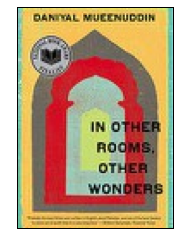 In Other Rooms, Other Wonders by Daniyal Mueenuddin – This is a book of several vignettes all taking place in Pakistan, not that long ago. It is about a place where there are modern feudal landowners and many poor people who work for them as servants, maids, sweepers, gardeners and other misc jobs. Some of the landowners are richer than others but no matter what class you are, you live your life with trials and tribulations. There is corruption everyplace. Everybody can be bought. The poor are essentially slaves to the upper class for whom they work. It is possible to get some reprise with sexual favors to the higher ups/ There is no real justice as people favor their families or people who pay them off. Stealing and lying are very common.
In Other Rooms, Other Wonders by Daniyal Mueenuddin – This is a book of several vignettes all taking place in Pakistan, not that long ago. It is about a place where there are modern feudal landowners and many poor people who work for them as servants, maids, sweepers, gardeners and other misc jobs. Some of the landowners are richer than others but no matter what class you are, you live your life with trials and tribulations. There is corruption everyplace. Everybody can be bought. The poor are essentially slaves to the upper class for whom they work. It is possible to get some reprise with sexual favors to the higher ups/ There is no real justice as people favor their families or people who pay them off. Stealing and lying are very common.
In one story a servant girl has a relationship with the master of the house. He dies and the estranged family and the wife and children send her away. In another story a young man from Pakistan goes to college and meets and American girl. They meet his family and his mother thinks that she will never really make her so happy. She isn’t sure either. Another story tells about relationship where a promiscuous young woman is about to settle down with a stable young man whom she believes she really loves but the relationship deteriorates. We meet a poor man who barely subsists with a portable shack and has the most menial job for a great feudal lord. He improves his lot a little by the generosity of a member of the owner’s family.
He finally marries a feeble minded woman and thinks he might have the semblance of family and maybe a child. He ends up with neither as she runs away. He is initially accused of kidnapping her and is beaten by the police. Eventually he returns home. His wife never returns and he dies a sad man.
What can possibly be the point of these stories? Certainly it is to tell us about the essential state of slavery that has existed in Pakistan for many years. Even the good deeds by a few people at times is not shown to be consistent with any real desire of those in power to change things. Certainly those without power are shown to have very little desire or ability to change the status quo. Not being very familiar with the history of Pakistan I can only hope that there has been some radical revolutionary changes there but I suspect neither.
It would be foolish to think that some unfairness only exists in Pakistan We know the history of this country about slavery and the remnants of discrimination that still exists. Despite a growing middle class we witness the lower class struggle in this country especially those who hold the poorest jobs often immigrants. So we can accept this book as more than a story about Pakistan but it still a stretch to feel that this is much of a contemporary tale of our society. It is hard to identify with the characters in these stories and overall it is a sad, depressing book which hopefully will help to keeps alive our empathic ability to change the world and establish basic fairness to all the inhabitants of this planet.
I Heard You Paint Houses by Charles Brandt
February 22nd, 2012 — 03:50 pm.
I Heard You Paint Houses: Frank” the Irishman” Sheeran and Closing the Case on Jimmy Hoffa- by Charles Brandt (2005 edition)
When his friend and mafia boss Russell Bufalino introduced a young Frank Sheeran to Jimmy Hoffa, Hoffa’s first words were, I heard you paint houses.” These are code words for “ I heard you do killings.” Little did any of these men imagine that many years later the last person who Hoffa would ever speak to would be Sheernan who killed Hoffa at the bequest of Bufalino. Not only did Sheeran “paint houses” but when required he could also do his “own carpentry” which means he could get rid of the body.
This book is the story of Frank Sheeran as told to Charles Brandt , a former homicide investigator, prosecutor and Chief Deputy Attorney General of the State of Delaware who had prosecuted many homicides in his day. For nearly five years, Brandt gained the confidence of an older Sheernan who was in his twilight years and knew that he was dying. These interviews occurred over numerous visits, many were video or audio recorded. There also were a few trips that were taken by the author, some with Sheernan to locations where “things had happened.” In the 2005 edition of this book there was an epilog with statements by some of the key players including Sheeran’s daughter which gives further authenticity to some the amazing stories in this book.
Sheeran grew up with a tough father in a tough Irish neighborhood. He relates an incident where he knocked out his school principal, breaking his jaw, after he was pushed around by him. He served overseas in Europe during World War II. He became a “sniper” which entailed killing lots of enemy troops. He also related that it was not an uncommon practice to kill prisoners of war in cold blood when it was not convenient to them bring them back for detention. He became a family man after the war, getting married and having children. He worked as a truck driver among other jobs and became involved in the union movement. The reader learns how it was quite common for him and his co-workers to steal merchandise that they were transporting and then sell it to increase their earnings. Such activities are presented as “ just making a living”.
Sheeran has a chance meeting with Russell Bufalino who turns out to be one of higher up Mafia bosses. Despite not being Italian he gains the trust of his new friend and meets many other mob connected people. When a reliable person is needed to “paint a house” Sheeran is someone who would handle the job. There were at least 20-30 such jobs including the famous hit of Joey Gallo and of course Jimmy Hoffa . The reason for the Hoffa hit, the consequences to Sheeran if he didn’t do it to one of his best friends, the details of it, and his subsequent feelings about it are all described in great detail.
While not described in as much detail, there is also information about another well known hit and that is the “whacking of JFK.” It is suggested that the mob needed to take some of the power away from Bobby Kennedy who as Attorney General under his brother was after the mob. Sheeran describes how he delivered the high powered rifles that were to be used for this shooting. As is often the case, the unsuspecting triggerman is killed after a big time hit. Jack Ruby is described as a well known member of the mob who was suppose to arrange for Lee Harvey Oswald to be eliminated after he killed Kennedy. When those plans were botched, Ruby had to do it himself.
In the end so many of the perpetrators of the big time mob activities described in this book ended up in federal prison. Some were turned against each other to get time off so they wouldn’t die in prison. Sheeran served his time and apparently never turned into “ a rat” …except in this book in a more less final confession before he died.
This book feels like a genuine window into the under belly of this world of crime and killings. If most of the participants were not already gone, you might almost feel that your life was in danger after reading this book for knowing all this information.
Postscript: There is a rumor that Robert DiNero is on board for playing the Irishman for a film project that will make of movie of this book with Martin Scorsese directing and also starring Joe Pesci and Al Pacino.
That Used To Be Us by Thomas L. Friedman and Michael Mandelbaum
October 20th, 2011 — 07:01 pm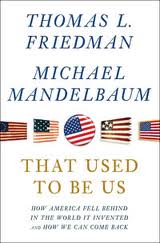 If you are to read one book about the contemporary US socio-political and economic condition, That Used to Be Us
If you are to read one book about the contemporary US socio-political and economic condition, That Used to Be Us is the book to read. The book is written by Tom Friedman, the popular NY Times columnist and author and his good friend and colleague Michael Mandelbaum, Professor and Director of American Foreign Policy at the Johns Hopkins University School of Advanced School of Advanced International Studies who is also author or co-author of several important books. They have collaborated on a very well thought out analysis how the US is on the path to becoming a second rate country and how we can get back to the way we used to be.
The case is made that there are four essential new realities, which our country is now confronted:
1- Globalization
2- The IT Revolution
3- The Nation’s budgetary deficit
4- The Pattern of Energy Use
Each of these issues is dissected and it is shown how we have failed to adequately deal with each of them. The authors analyzed why we have been unsuccessful but they also tried to delineated the pathway that the US could follow back to greatness. Their style is one of facts and logic with numerous examples. They present their analysis with an empathic approach, which clearly comes from two people who clearly care about the country. While, I believe that they have some political bias, the book is not written from an ideological viewpoint or with a particular political agenda.
They explain at this time of globalization and the IT revolution, it is essential that the country address education, infrastructure, immigration, research and development and appropriate regulations which controls each of this categories. The failure of the US to rebuild it’s infrastructure of roads, rails, schools etc. misses the opportunity to create sorely needed new jobs and the failure to recognize global warming is a missed opportunity to develop new green industries. The authors repeat a suggestion that Friedman has been making for years that an oil tax would be a significant step in making the US less dependent on foreign oil and would also facilitate the development of a valuable alternate industry in the US. They explained that the budget deficit problem has to be understood by realizing that unemployment is remaining high even with the return of a great deal of the lost productivity. This is because of the IT revolution and the ability of computers and digitization to replace many old jobs. The authors make no bones about the absolute necessity of raising taxes and reducing entitlements in a bipartisan manner. They contrast the philosophy of the “Greatest Generation.” of saving for the future and the “Baby Boomers who are borrowing from future generations.
This book is geared towards the future and therefore, the discussion of education was one it’s most important contributions in this comprehensive look at Problem America.
Starting off with the simple statistic that we have had zero job creations since 1999 and taking into account the nature of globalization and the IT revolution, it is no surprise that a good part of the solution is investing in education. This means valuing teachers, principals, and an education system which can not only produce students who score on world wide standardized tests but students who from an early age can learn how think innovatively and creatively. A wonderful example is given how teachers can be valued comes from Williams College. In preparation for their graduation their seniors nominate their best high school teachers. The nominees are then carefully vetted .The top twenty or so are chosen to be honored at the Williams graduation and partake in special seminars in their honor during graduation week. Other such programs are described which are examples how teachers and principals can be rewarded in intangible as well as monetary ways.
One of the things that makes this book so special is that there are not only many micro-examples such as this one but there are macro-examples as well as metaphors, stories from films, books and everyday life. There also is a concluding chapter about “shock therapy” which is a potential political event, which if it happens might just cause the turning point that we need. You come away from reading this book with a feeling that the US is clearly in trouble but we have a 200-year history of pulling together to solve problems and of rising to the occasion to achieve leadership and greatness in the world. The book provides some well needed optimisms as to whether we can become “the way that used to be us.”
My Life by Bill Clinton
April 28th, 2011 — 03:07 amBuy now on Amazon: My Life by Bill Clinton
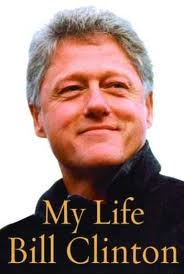 I have always known that Bill Clinton is a warm friendly guy but I never have had any personal contact with him- that is up until now. This autobiography makes you feel that he is sitting in your living room chatting with you. Chatting in some detail!! In addition to his obviously very good memory for faces, people and events he also met regularly during his presidency with a person who helped record an oral history which he was able to draw upon, as well as all appointment books and official papers, along with a staff to help him. But the product is still Bill talking away in great detail – often fascinating detail about the story of his life and story of the history that he made as President of the United States.
I have always known that Bill Clinton is a warm friendly guy but I never have had any personal contact with him- that is up until now. This autobiography makes you feel that he is sitting in your living room chatting with you. Chatting in some detail!! In addition to his obviously very good memory for faces, people and events he also met regularly during his presidency with a person who helped record an oral history which he was able to draw upon, as well as all appointment books and official papers, along with a staff to help him. But the product is still Bill talking away in great detail – often fascinating detail about the story of his life and story of the history that he made as President of the United States.
As he recounts his childhood and the early details of his life, he foreshadows his ability to connect with people and maintain them as friends. For example as a small kid maybe 5 or 6 years old in Arkansas there was a rich kid who lived across the street in a larger house . Bill was grateful that the boy’s parents and the kid were very friendly to him and invited him over to play. That kid was Mack McLarty who became his first White House Chief of Staff and one of his most trusted advisors. This story was played out time and time again as for example several of his college buddies who he met at Georgetown some of whom he met because they lived near him in his dormitory freshman year, were appointed to responsible jobs in his administration and were very special to him. Hence, the informal designation FOB – friends of Bill. While I don’t recall it was used in the book, it is certainly is a category which includes many people.. Clinton’s ability to relate, tied together with a tremendous memory, especially for people, was a great political asset. When he was running for Governor he would travel throughout the state and meet many people from all walks of life often in small towns, in diners, gas stations and sometimes in their homes. He would personally come to understand their special story along with their hopes and aspirations. When running for President about 20 years later he recognized these people on the campaign trail and reconnected with them. Of course there was no one in his early life that he felt closer to than his mother and his brother. His biological father had died before he was born.
Obviously he is a very bright guy who made it into Yale Law School and yet could skip some of classes in his freshman year so he could take on local responsibilities as part of the Democratic Party presidential campaign of that time
Clinton’s determination and ambition were demonstrated early in his political career. He rose quickly from Attorney General of Arkansas to Governor but was defeated in his quest for a second term . Hence the “ Come Back Kid “ as he then bounced back and was elected Governor’s for another two terms. The details of who encouraged him, who he emulated and how he conceptualized himself as a political person but yet as a person who really wanted to do things for people is all spelled out in great detail as you go on this journey with him through this book.
Reading this book is also like thumbing through an old family photo album and seeing people you know well as adults, but viewing them as young people just getting started.
His version of his encounter and relationship with Hillary comes across as a good friend who might be telling you about the details of the courtship with his wife. We come to appreciate the decisions that Hillary made to be with Bill and support him, long before she knew he might have such momentous success and the opportunities that would open up for her We meet George Stephanopoulos as a young untested campaign worker and of course we know how he ultimately became one of Clinton’s most trusted advisors and now is national network commentator. This story is repeated for so many familiar people.
Some critics have suggested that this book may be a little too long. But the fascination of this young man who grew up to be a two term President is in the details, It is the behind the scenes discussions, strategies, encountering dirty politics around him, the excitement of coming from behind, the election evenings, crisis in the White House and so much more, is what makes this book so valuable.
What also comes across in this book is Clinton’s genuine feelings for the oppressed and his desire to help people who can’t help themselves or those who are treated unfairly. His views of civil rights clearly come form his childhood and early experiences which allowed him to appreciate the prejudices which so many blacks in his southern rural area were experiencing and which he saw as wrong. As President, when he developed programs which were going to help downtrodden people, he was constantly relating them to people he knew and could name. This was quite consistent and very impressive.
Clinton’s early propensity for making and keeping friends is a recurrent theme throughout the book. Perhaps because he genuinely made good connections with people, he didn’t seem to question, as his career progressed, that famous celebrities, titans of industry and leaders of other countries valued his friendship because he was the most famous and powerful person in the world. He seems to take for it granted that the Prime Minister of Great Britain, the leader of the Russia, Princes and Kings were his good friends and that during and after his term in office he and Hillary would have dinner with them as one might be getting together with an old college buddy (which Clinton would also do). A most illustrative example of how he perhaps had a slight blind spot in this regard, is the story of Barbra Streisand and his mother. His mother was a great fan of this iconic singer. Therefore during the campaign, Clinton was thrilled when he could introduce his mother to Streisand. He then goes on to say they got along very well, became “very good friends” and they spoke weekly on the phone for many years??
Clinton knew if he were going to write a meaningful autobiography he was going to have to write about his sexual lapses, his impeachment and how he avoided having to step down as President. He acknowledged making a great mistake in his interactions with Monica Lewinski, a White House intern, and how he tried to avoid publicly acknowledging it. He related some of the details how he dealt this his wife and daughter in the face of this great humiliation. He shared how he was forced to sleep on the couch as Hillary came to grips with what he had done. However he goes into great detail of how he believes the Special Prosecutor Ken Starr over stepped his bounds and his authorization in trying to bring down the Clintons, first for Whitewater (accusations which were never proved of impropriety related to Hillary’s work with her law firm in Arkansas) and then extending his attacks against Clinton and trying to get information which would allow Congress to remove him from the presidency. He documents in some details what he believes were very unfair and untrue accusations, which were knowingly made by Starr against him, and how people who were his friends were badly treated because they would not misrepresent the truth. This segment of his biography will someday make a great documentary, movie, book, TV program etc.
Clinton had an opportunity to be president during a relative period of prosperity perhaps in part because of his policies. He was able to balance the budget (can you imagine that?) and sign into law quite remarkable legislation impacting our environment, healthcare
and social change. He spells them out and you can feel his passion and how proud he was of these accomplishments. He also recounts in great details what could have been perhaps his greatest accomplishment but yet fell short through no fault of his own. That was peace in the Middle East. He personally worked very hard with both sides and in the end had a solution which the Israelis could accept and many of the Arab nations including many Palestinians thought was fair but for some indefinable reason Arafat was not able to sign. Years later when Arafat wanted to sign on to these same things, the pendulum had past and the opportunity was lost (at least for then) .
The epilogue and any perusal of modern current events will reveal that Clinton has put his energies, his ability to raise money and his brilliance all in the service of humanity as he continues with trying to develop educational opportunities, provide treatment of AIDS and promote social change throughout the world. .
It is well known that one of the ways to go down in history is to write the history. That certainly is what a President who writes an autobiography is doing. Time will tell whether Clinton was as great a president. Despite his human foibles he has presented himself and the history of his life as a wonderful model for young Americans who want to make a difference in public service. His energy, sprit and caring for others is also a life lesson which we only hope might be contagious to many of the readers of his book..

